March 27, 2020, by Kathryn Steenson
Homage to the Arboreal World
Trees have long been of significant importance to the human species. Our relationship with trees began with their ability to satisfy neolithic needs such as shelter and nutrients, which progressively shifted towards trees’ later central contribution to the evolution of agriculture and machinery. Indeed, major socio-economic changes over the 15th to 18th Centuries saw the timber industry culminating as one of the populations’ largest sources of natural materials. The increase in demand for forest products over the last 50 years has, however, resulted in widespread deforestation, posing threat to our delicate biosphere. Our current relationship with trees is unbalanced, and has become one of exploitation.
In light of the current political and ecological climate, we can turn to the past to best assess how to shape a more eco-conscious, sustainable world for the future. Through demonstrating how populations have used and valued trees in the past – specifically in Nottinghamshire and surrounding areas – this display attempts to communicate the significance of tree conservation in restoring the much-needed balance between human development and environmental preservation, striving towards a more appreciative attitude towards the tree species.
“She could tell them about a simple machine needing no fuel and little maintenance, one that steadily sequesters carbon, enriches the soil, cools the ground, scrubs the air, and scales easily to any size. A tech that copies itself and even drops food for free. A device so beautiful it’s the stuff of poems”
Richard Powers, The Overstory
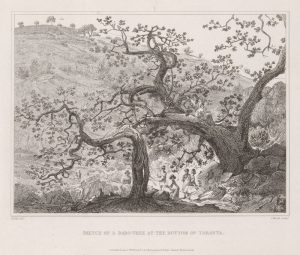
Sketch of Daro Tree, from Henry Salt’s ‘Voyage to Abyssinia’; 1814 (Ref: Travel Collection Over.X DT377 .S2 barcode SC 75798)
This engraving sketched by English artist and traveller, Henry Salt, perfectly depicts human fascination and attraction to trees. In this particular sketch, the Daro Tree represents a communal space for gathering and relaxation; people can be seen using the tree’s shade, using it’s branches as a place to rest. The image represents how trees have long been central to human socialisation across cultures, demonstrating our magnetism to the tree species.
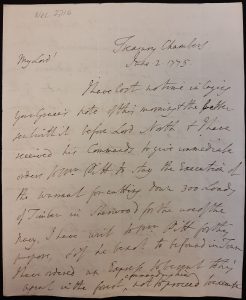
Letter from Sir G. Cooper, from the Treasury Chambers, London, to H.F.C. Pelham-Clinton, 2nd Duke of Newcastle under Lyne; 2 June 1775. (Ref: Ne C 2716)
During the 18th Century, England largely depended on timber from American Colonies for use by the Royal Navy, due to English forests being predominantly felled for farmland in the 1600s. British Parliament Acts of 1711, 1722 and 1772 intended to protect owned trees across seas, particularly preventing felling of white pines by American colonists which were needed for masts – however, of the trees reserved for British Navy use, only only one percent were actually used for masts. Tree protection acts therefore resulted in rebellion, beginning with the Pine Tree Riots of New Hampshire, 1772, culminating in the American Revolution, April 1775.
This letter, written June 2nd, 1775, reveals Sir G. Cooper stopping the warrant for cutting down ‘300 loads of Timber in Sherwood Forest for the use of the Navy’ with the aim of preserving British timber due to troubles between the American Colonies and the Royal Navy. The significance of the letter lies in its historical context, demonstrating the contribution and preciousness of trees for British Imperialism.
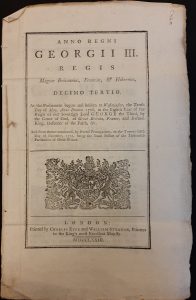
Act to extend the Provisions of an Act, made under George III (‘An Act for the better preservation of timber trees, and of woods and underwoods; and for the further preservation of roots, shrubs and plants’) to Poplars, Alder, Maple, Larch and Hornbeam; 1772-1773. (Ref: Ga 12075)
The Act to protect timber trees and wooded areas was extended in 1772-1773 to encompass further tree species. As a result of colonial riots in the Americas, the Britain recognised the importance of preserving trees on British soil, demonstrated through this Act whereby anyone who was to “break down, bark, burn, cop” or “deface, damage, spoil, destroy or carry away” trees without consent of land owners or surveyors would be fined. The importance of preserving trees in this period is shown through Governmental involvement in matters of tree and woodland preservation on a national scale.
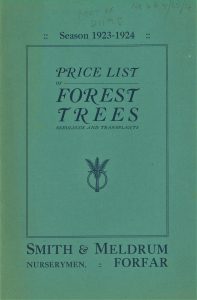
Price List of Forest Trees, from Smith & Meldrum Nursery in Forfar, Scotland; 1923. (Ref: Ne 6 E 4/65/4)
This catalogue and price list of forest trees for the season 1923-1924 from the Smith & Meldrum Nursery demonstrates the monetary value of trees across the United Kingdom, including how our economy has long relied upon foresting as a core industry.
This Order was devised to stop persons from cutting down or destroying trees, specifically in woodland areas. Consent from authorities was required for any exclusions, but any persons contravening the provisions of the Order was guilty of an offence and liable for a fine – trees destroyed were to be replaced with another tree of appropriate size, species and value, demonstrating the shift towards tree conservation in local areas.
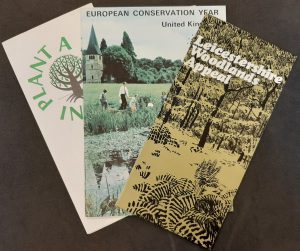
Leaflets and publications surrounding nature conservation; 1969-1975 (Refs: Nc 15/5a; Nc 15/11c; Nc 15/12a)
These publications and leaflets predominantly demonstrate the heightened interest in nature conservation during the late 60s, early 70s. At both the international and local level, there was a surge in encouraging the preservation of nature sites, including forests and woodlands in particular.
European Conservation Year (1970) aimed at constituting policies for environmental conservation, whilst educating citizens of the EU surrounding the need for collective action to ensure nature protection. Over 20 Countries turned their attention to the damage caused by urbanisation, agriculture and the forestry industry. Interventions were rolled out on a national scale, with projects such as tree planting taking place across the country supported by local authorities, trusts, government departments and commercial entities alike.
The ‘Plant A Tree in 73” campaign, issued by the Department of the Environment, aimed at promoting the planting of trees by local residents, schools and organisations in order to “lay down roots for a tree-filled future”. The campaign demonstrates recognition of significance of trees for a healthy environment.
The Nottinghamshire Trust for Nature Conservation demonstrates here focus on tree preservation trees in the local area. Despite the monetary value of the sites (potential timber, possibility to fell trees for agricultural use) the Trust attempts to turn the areas into nature reserves, making arrangements with County Planning Departments and land owners to preserve the trees and woodlands. Notably, in this description, the Trust had plans to compensate the owners thousands of pounds for the conservation of the site, revealing strong recognition of the ecological value of trees.
This is a guest post by Annabel Stubbs, undergraduate Psychology student on the Experience Heritage University of Nottingham Module. The original manuscripts and rare books are part of Manuscripts & Special Collections. More information about our holdings and the online catalogues is available from our website.
No comments yet, fill out a comment to be the first

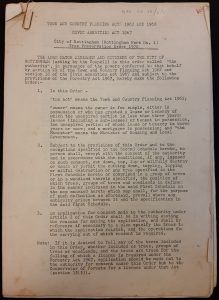
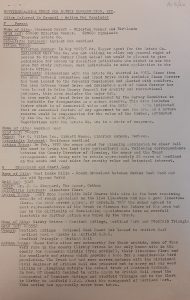
Leave a Reply